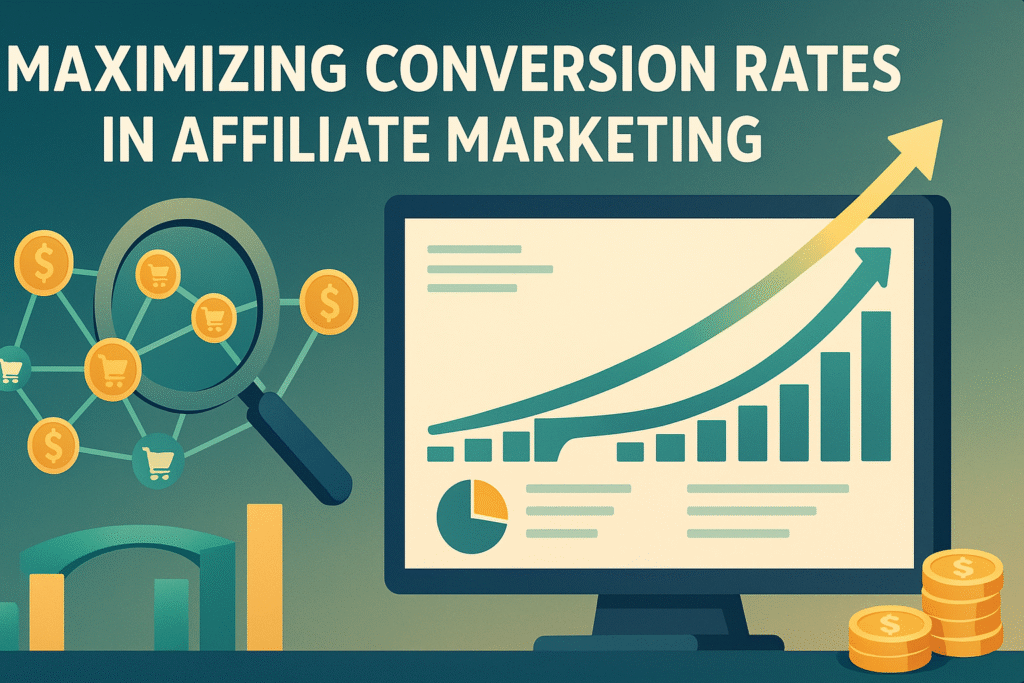Maximizing Conversion Rates in Affiliate Marketing
Affiliate marketing is an excellent way to earn passive income, but like any business model, it requires a strategic approach to maximize results. Whether you’re just starting or looking to optimize your existing efforts, understanding how to boost your conversion rates is crucial. In this blog post, we’ll explore effective strategies to enhance your affiliate marketing performance, turning clicks into conversions. Let’s dive in! 🚀
Table of Contents
1. Understanding Conversion Rates
2. Identifying Your Target Audience
3. Creating High-Quality Content
4. Optimizing Landing Pages
5. Leveraging Email Marketing
6. Utilizing Social Proof
7. Analyzing and Adapting Strategies
8. Conclusion
9. FAQs
Understanding Conversion Rates
Before we get into the nitty-gritty of maximizing conversions, let’s clarify what conversion rates are. Simply put, a conversion rate is the percentage of visitors to your site who take a desired action. In affiliate marketing, this usually means clicking on an affiliate link and making a purchase. Knowing your baseline conversion rates is essential, as it allows you to measure improvements over time.
Identifying Your Target Audience
The foundation of any successful affiliate marketing strategy lies in understanding your target audience. Who are they? What problems do they need solving? What products resonate with them? By answering these questions, you can tailor your content and marketing efforts to meet their needs, significantly boosting the likelihood of conversion. Remember, a well-defined audience is more likely to engage with your content and trust your recommendations.
Creating High-Quality Content
In affiliate marketing, content is king. Crafting high-quality, informative, and engaging content builds trust and positions you as an authority in your niche. Whether it’s through blog posts, videos, or social media posts, ensure your content provides real value to your audience. Use storytelling to connect with your readers on a personal level, and don’t shy away from sharing personal experiences with the products you promote. Authenticity sells! ✨
Optimizing Landing Pages
Your landing page is often the first impression potential customers have of your brand. A well-optimized landing page can significantly improve conversion rates. Focus on clear, concise messaging, eye-catching visuals, and a strong call-to-action (CTA). Make sure your page loads quickly and is mobile-friendly, as slow or difficult-to-navigate pages can turn potential customers away. A/B testing different elements on your page can also provide insights into what works best.
Leveraging Email Marketing
Email marketing remains one of the most effective channels for affiliate marketers. Building a subscriber list gives you direct access to potential customers who have already shown interest in your offerings. Craft personalized and engaging email campaigns that offer value, such as exclusive discounts or insider tips. Keep your emails concise, with a clear CTA that directs readers to your affiliate links. Remember, consistency is key—nurture your relationship with subscribers over time.
Utilizing Social Proof
Social proof is a powerful psychological trigger that can significantly influence purchasing decisions. Showcase testimonials, reviews, and case studies to demonstrate the value of the products you promote. User-generated content, such as photos or stories from satisfied customers, can also be incredibly persuasive. Social proof not only builds trust but also creates a sense of community and belonging among potential buyers.
Analyzing and Adapting Strategies
Finally, maximizing conversion rates in affiliate marketing requires continuous analysis and adaptation. Use analytics tools to track the performance of your campaigns and identify areas for improvement. Pay attention to metrics like click-through rates, bounce rates, and conversion rates. Don’t be afraid to experiment with new strategies or pivot if something isn’t working. The digital landscape is always evolving, and staying agile is key to long-term success.
Conclusion
Maximizing conversion rates in affiliate marketing is a dynamic process that involves understanding your audience, creating compelling content, and continuously refining your strategies. By focusing on the needs and preferences of your audience, optimizing your platforms, and leveraging data-driven insights, you can turn more visitors into loyal customers. Remember, success in affiliate marketing doesn’t happen overnight, but with persistence and the right approach, it’s within reach. Happy marketing! 🎉
FAQs
Q: What is a good conversion rate for affiliate marketing?
A: While conversion rates can vary by industry, a typical affiliate marketing conversion rate is around 1-3%. However, with the right strategies, it’s possible to achieve higher rates.
Q: How can I track my conversion rates?
A: Use tools like Google Analytics, affiliate network dashboards, or specialized affiliate tracking software to monitor your conversion rates and other key metrics.
Q: How often should I update my content?
A: Regularly updating your content keeps it relevant and engaging. Aim for at least once a quarter to refresh your posts and incorporate new insights or product updates.
Q: Is email marketing still effective in 2023?
A: Absolutely! Email marketing remains one of the most effective ways to reach and convert your audience, especially when emails are personalized and well-targeted.
With these strategies in your toolkit, you’re well on your way to improving your affiliate marketing conversion rates. Good luck, and may your affiliate links be ever-clickable! 😊
Check out our sister site for the best affiliate programs of 2025

